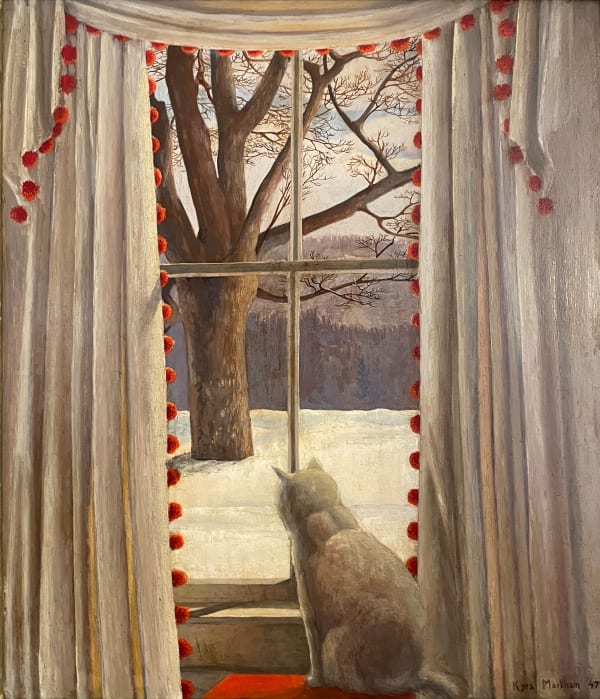Works
Biography
Louise Nevelson is best known for her large-scale, monochromatic, painted wood assemblages. She was a harbinger of feminist and installation art that rose to prominence in America in the mid-twentieth century. Her sculptures reflect her interior life, women’s roles in society, the urban landscape, personal symbolism and spirituality.
Nevelson was also well-known for her cultivated style and no-nonsense personality, both of which helped sustain her tenacious confidence over the course of five decades, as the art world came around to celebrating her work and its impact.
Louise Nevelson was born Leah Berliawsky in 1899 in a part of Ukraine that is now Russia. In 1905 her family immigrated to Rockland, Maine to escape the persecution the Jewish community suffered under Tsarist Russia. Nevelson had artistic aspirations from an early age and in 1920, after marrying the son of a wealthy businessman, she and her husband moved to New York City. She gave birth to a son in 1922 and began taking classes at the Arts Students League in 1928.
Finding it difficult to balance her family and her ambitions, she and her husband divorced in 1931 and she traveled to Munich to study under Hans Hofmann. The following year, Hofmann immigrated to America and Nevelson followed suit, returning to New York. She once again studied at the Art Students League, working under George Grosz and Chaim Gross and also worked for the Works Progress Administration, where she encountered many of the era’s soon-to-be-famous artists such as Jackson Pollock and Willem de Kooning.
Nevelson’s work began attracting attention in the early 1940s, though financial success belied her early efforts. Being a woman, along with creating large, ambitious works made from refuse wood, contributed to the lack of initial fanfare around her work. In the 1950s she began being showing at respected galleries in New York, including Martha Jackson Gallery and Pace Gallery (who still represents her work today) and her work was critically favored, but not fully embraced or understood by the art market.
In 1959, Nevelson’s Dawn’s Wedding Feast was shown in the Museum of Modern Art’s seminal exhibition of avant-garde contemporary art, 16 Americans. Also included in that show were works by Jasper Johns , Frank Stella and Robert Rauschenberg. Nevelson was working within a similar mode as many of the era’s abstract expressionist painters—creating work out of an inner, emotional, self-guided searching, rather than from any obvious relation with culture or nature. Her assemblages, though made out of salvaged, mismatched wood, are unified and elegant in their depth and interior rationality.
Dense and lyrical, these works speak to celestial bodies, personal myth-making, and psychological landscapes. The Whitney Museum of American Art held Nevelson’s first retrospective in 1967 and in the 1970s, when Nevelson was in her seventies, she began receiving commissions for large, outdoor sculptures, which inspired her to work with new materials such as steel. Nevelson died in 1988 in New York, leaving behind a legacy of sustained creative persistence and vision that influenced scores of young artists that came after her.
Nevelson was also well-known for her cultivated style and no-nonsense personality, both of which helped sustain her tenacious confidence over the course of five decades, as the art world came around to celebrating her work and its impact.
Louise Nevelson was born Leah Berliawsky in 1899 in a part of Ukraine that is now Russia. In 1905 her family immigrated to Rockland, Maine to escape the persecution the Jewish community suffered under Tsarist Russia. Nevelson had artistic aspirations from an early age and in 1920, after marrying the son of a wealthy businessman, she and her husband moved to New York City. She gave birth to a son in 1922 and began taking classes at the Arts Students League in 1928.
Finding it difficult to balance her family and her ambitions, she and her husband divorced in 1931 and she traveled to Munich to study under Hans Hofmann. The following year, Hofmann immigrated to America and Nevelson followed suit, returning to New York. She once again studied at the Art Students League, working under George Grosz and Chaim Gross and also worked for the Works Progress Administration, where she encountered many of the era’s soon-to-be-famous artists such as Jackson Pollock and Willem de Kooning.
Nevelson’s work began attracting attention in the early 1940s, though financial success belied her early efforts. Being a woman, along with creating large, ambitious works made from refuse wood, contributed to the lack of initial fanfare around her work. In the 1950s she began being showing at respected galleries in New York, including Martha Jackson Gallery and Pace Gallery (who still represents her work today) and her work was critically favored, but not fully embraced or understood by the art market.
In 1959, Nevelson’s Dawn’s Wedding Feast was shown in the Museum of Modern Art’s seminal exhibition of avant-garde contemporary art, 16 Americans. Also included in that show were works by Jasper Johns , Frank Stella and Robert Rauschenberg. Nevelson was working within a similar mode as many of the era’s abstract expressionist painters—creating work out of an inner, emotional, self-guided searching, rather than from any obvious relation with culture or nature. Her assemblages, though made out of salvaged, mismatched wood, are unified and elegant in their depth and interior rationality.
Dense and lyrical, these works speak to celestial bodies, personal myth-making, and psychological landscapes. The Whitney Museum of American Art held Nevelson’s first retrospective in 1967 and in the 1970s, when Nevelson was in her seventies, she began receiving commissions for large, outdoor sculptures, which inspired her to work with new materials such as steel. Nevelson died in 1988 in New York, leaving behind a legacy of sustained creative persistence and vision that influenced scores of young artists that came after her.
Press
Exhibitions
Enquire



